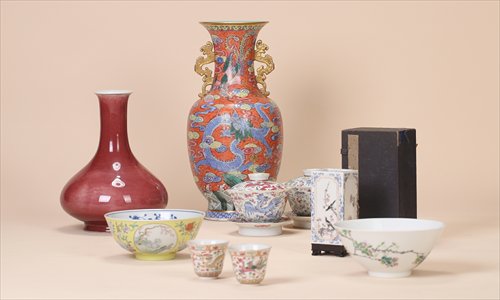Auctions sold on summer
By Xiong Yuqing Source:Global Times Published: 2013-9-25 19:23:01

Summer auctions feature antiques that sell for mid-level prices below 1 million yuan. Photo: Courtesy of Beijing Council International Auction Company
While most auction houses were busy preparing for their big autumn events, the Beijing Council International Auction Company saw their new emphasis on summer auctions pay off.
This year's summer art auction of the Beijing Council on September 12 grossed 101 million yuan ($16.5 million), with Chinese paintings and calligraphies taking in 83 million yuan and porcelains and other pieces bringing in 17 million.
Xie Xiaodong, the deputy general manager of Beijing Council, expressed his satisfaction with this result to the Global Times.
"It is our first time organizing [the annual summer auction], and it only lasts one day," Xie said. "The result reflects the strength of our brand and it is a good start for us to develop the medium-sized auction market."
Attracting new buyers
Though Beijing Council set up their first summer auction in 2011, the previous events were quite different from the most recent one. Xie said they plan to build a brand focusing on mid-level auctions with annual summer auctions and early spring auctions, which will first start in March of 2014. The medium-sized auctions are selling pieces with much lower prices than those in spring and autumn, and the basic price is usually less than 1 million yuan.
According to a report on Shanxi News, more than 40 percent of attendees at the spring sales this year were new buyers. The first-time buyers are usually cautious when selecting goods, and they are not willing to place high bids on risky items.
More than 30 percent of the buyers at the summer auction were first-timers, according to Xie. The wide range in price and quality offers potential buyers more choices.
In the summer auction, some higher quality artworks sold at considerable prices that crossed the 1 million yuan threshold usually only surpassed in the larger spring and autumn auctions. At this year's summer auction, 16 pieces went for more than 1 million yuan. The highest bid of 4.26 million yuan was for Si Shi Qun Fang (Blossoms of Four Seasons), a four-screen painting by a master of gongbi, a fine brush stroke technique, Yu Fei'an (1888-1959).
Dong Guoqiang, chairman of the Beijing Council, explained to cnstock.com that the summer auctions are not held to supplement spring and autumn sales.
"We have an independent team working for the summer auction to control the quantity and quality of the projects," Dong said.
Testing the domestic market
Some international auction companies such as Christie's have already built their own system of mid-level auctions.
For overseas auction houses, medium-sized sales are standard and frequent happenings. Xie praised the summer auctions abroad for their diversity.
"They offer more types of objects, such as automobiles, musical instruments and daily supplies, with a wider range of price," Xie said.
Different from the mature auction market abroad, the Chinese art market is still undergoing changes and modifications to suit demand. Both the Ministry of Culture's Chinese art market annual report for 2012, published last month, and annual research conducted by the China Association of Auctioneers show a 15 percent decline in 2012 from the previous year.
But the spring sales this year saw a slight rebound. Besides the growing number of goods selling for 10 to 50 million yuan, the medium-priced pieces are the most popular ones among collectors.
Xie said the mid-level auctions could explore new categories and themes, and develop into larger events with time. Some items such as Chinese art paper aren't a common sight in Chinese auctions, but their market potential can be tested out in the summer auctions.
The summer auction of the Beijing Council contained different types of objects, such as items for tea ceremony, chop stones and contemporary luxuries. It also included special, themed series, such as a group of items from the same collector. Still, the high price hitters were still mainly traditional paintings and calligraphy.
"The domestic auction market still focuses on artwork," concluded Xie. "But the medium-sized tests are helpful for buyers to learn more about the auction market, and to make more items desirable."
Comparisons with galleries
Xie indicated that future mid-level auctions of the Beijing Council will focus on traditional paintings and modern art. The rareness of ancient paintings makes them stable in the higher price ranges, and artwork by different genres of Chinese contemporary artists also fetches considerable prices at the summer auction.
In recent years, some artwork is sold for an even lower price in the medium-sized auctions than in galleries. This became a hot topic on whether the viability of galleries is impacted by art auctions.
According to the 2012 Statistics Analysis Report on Cultural Development by the Ministry of Culture, in 2012, original artwork sold for 97.5 billion yuan at auctions, accounting for 46 percent of all sales of original art. Sales by galleries, art agencies and art expos collectively comprised only 17 percent of sales.
Dong told cnstock.com that domestic galleries are not influential enough to introduce new artists to customers. As the influence of auctions is larger than galleries, auctioneers are the ones introducing and developing new potential in the art market. Sometimes, gallery owners even come to art auctions to select artwork and get acquainted with artists.
Some customers also prefer to go to art auctions to directly purchase art.
According to a report published in People Digest in June 2013, art collecting in China remains in a rudimentary stage, as many collectors and investors judge the artwork at auctions by the auction price, rather than the style or level of craftsmanship and artistic value.
Posted in: ARTS